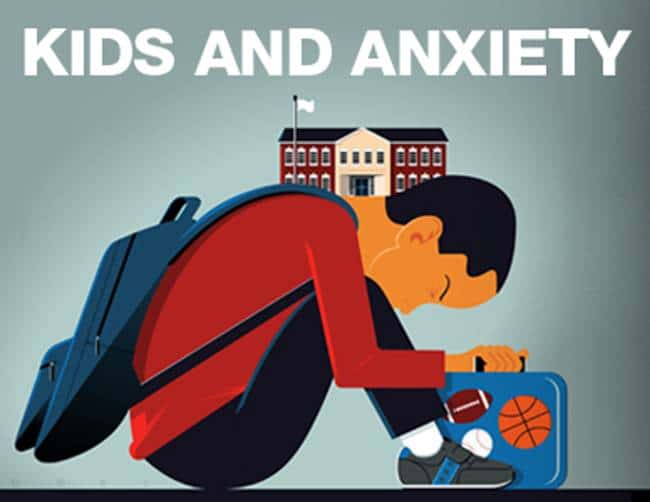
It started with simply driving down the street.
The little girl in treatment for selective mutism — an anxiety disorder in which a child is unable to speak in certain situations — was entering kindergarten in September. The transition to a new school was a carefully planned, step-by-step process that began months before.
In the spring, the Wyckoff family would drive past the new school. At times, they stopped and went to the school’s playground. Eventually she toured the school building, slowly meeting staff members. Over the summer, she helped her teacher set up the classroom. The gradual process helped her face her fear of talking at school and to strangers and her more generalized social phobia.
“By the time [she] attended the orientation, she had already met and spent time with many of the school staff members,” said her dad, Rob Mortorano. “They told us she did very well that day. We felt the only reason she did so well was because of all the steps prior to that day.”
The Mortoranos were putting cognitive behavioral therapy into action. During this time, their daughter went to weekly sessions with her psychologist and discussed the steps taken and what was next.
CBT is a type of talk therapy that has been scientifically shown to be effective in treating anxiety disorders. It teaches skills and techniques to a child to reduce and control her anxiety. More than 40 studies have shown that the therapy is effective, making it an evidence-based psychological treatment.
It is the research data that can give parents confidence in the treatment, according to Cresskill psychologist Matthew Goldfine.
“Just like I wouldn’t want to take a pill or medicine that hasn’t had clinical trials, I wouldn’t want my child to engage in therapy where there hasn’t been some documentation that it will work,” said Goldfine, who specializes in treating children with anxiety disorders.
‘Worry Bully’
Cognitive behavioral therapy follows a very specific process. It begins with educating parents and the child about anxiety and what it does and how it makes them feel and respond. The child is then taught relaxation exercises and ways to be aware of any triggers or know early on when anxious feelings are cropping up. Therapists will talk about the “Worry Bully” or use similar phrasing to help kids understand this thing that is pushing them around and forcing them to feel and behave in ways they don’t want to.
The therapy moves on to gradual exposure to the things that make a child anxious, whether it’s germs, being away from parents or speaking aloud in class. They are conquered one small step at a time, using a “bravery ladder” or “challenge stairs” or some similarly labeled step-by-step process from most easily accomplished to most difficult or anxiety-inducing.
“Research shows that exposure in graduated ways to the things you fear is the only thing that helps anxiety,” said psychologist Lynne Siqueland of the Children’s Center for OCD and Anxiety in Plymouth Meeting, Pa. “Cognitive behavioral therapy is all about exposure.”
While the treatment protocol calls for a timeline of anywhere from 12 to 20 weeks, children move at their own pace. It may take a few times to get up one step, or they may fall back at times and have to repeat a couple.
This series focuses on how anxiety affects North Jersey kids, their families, school systems and the mental health community.
There are also intensive programs, mostly held at university-affiliated clinics at Columbia, the Weill Cornell, New York University, Temple University and Boston University. In these weekend or weeklong programs, kids are taken through the CBT protocol in fast-forward, compacting what would be weeks of sessions into one day.
Life can get worse before it gets better. When a family enters treatment, the child is asked to do things that make him anxious, and the family is asked to step back from accommodating that anxiety.
“Initially, what might happen is the child may get very upset They will feel uncomfortable,” said Rob Zambrano, a cognitive behavioral therapist at Stress and Anxiety Services of New Jersey in East Brunswick. “They cry. They tantrum. And part of my job is to sort of help the family respond to that too and understand if we give in, the child is not given the opportunity to make improvements they need to make.”
Parental patience is stretched further.
“We’re changing up a system that’s just barely holding together by a thread,” said Zambrano. “I’m pulling out a thread. But I’m doing that not because I want to torture families, but because I know in the long run, this is the effective thing to do. This is the way to get better.”
Parents like the goal-oriented, structured CBT program, according to psychologist Carrie Spindel Bashoff, who compares the therapy to any consumer product.
Gauging outcomes
“You go in, and you want a product, and you want to be able to see and measure that outcome,” said Bashoff, who sees children in Hackensack, Montclair and Manhattan. “Parents want to see the same thing. They are coming in for a reason, and they want to know exactly how this is going to be corrected and what they can expect along the way. A structured program fits nicely with that.”
It is a very specific program and one that may not be followed by all therapists who say they do cognitive behavioral work.
“There a lot of people who say they are cognitive behavioral therapists, but they went to a workshop somewhere on a weekend,” said Zambrano. “I’m always on the lookout for somebody who says they’re eclectic.
“If you look at their profile, it says I’m psychodynamic, psychoanalytic and a cognitive behavioral therapist,” he said. “Right there, already, my antenna is up. They may not be someone who delivers cognitive behavioral therapy the way we were trained to and the way the people who intensively do this work do it.”
The Anxiety and Depression Association of America’s website notes, “No one treatment method works best for every child; one child may respond better, or sooner, to a particular method than another child with the same diagnosis.”
The ADAA lists cognitive behavioral therapy as the primary therapy option for kids with anxiety disorders and offers two “other forms of therapy” as options:
- Acceptance and commitment therapy, or ACT, uses strategies of acceptance and mindfulness (living in the moment and experiencing things without judgment) as a way to cope with unwanted thoughts, feelings and sensations.
- Dialectical behavioral therapy, or DBT, emphasizes taking responsibility for one’s problems and helps children examine how they deal with conflict and intense negative emotions.
Psychoanalysts like Dr. Nathanial Donson of Englewood believe their method can work, as well, as long as the child is old enough to “play, talk and relate.” Donson, who is quick to point out he is not opposed to any therapy that works, sees a lot of common ground in the different theories of thought including CBT, family therapy and other approaches. His work can be intense and time-consuming.
“It’s long, and it’s hard, and it requires a family to think that I know what I’m doing,” said Donson. Psychoanalysis “looks at the inside life of the person that we’re worried about and tries to help them rework their inner lives, such as to be more comfortable with the world as it is. And it’s a pretty crazy world.”
No matter the treatment, cost may become an issue. Most specialized providers are out-of-network, and out-of-pocket payments can be prohibitive. For families that find a way to afford it, there is a choice of what kind of approach to take.
The fundamental difference of thought between CBT practitioners and psychoanalysts is the idea that there is an underlying dynamic that must be resolved, not just an anxiety issue where triggers and symptoms are treated and coping skills learned.
Analytic approach
“My interest in anxiety has to do with either conscious or unconscious personal conflict within one self,” said Donson. “Those conflicts are immobilizing and signaled by anxiety and may sometimes become overwhelming, and you can’t do anything about it. That’s a psychodynamic position. … .
“The analytic treatment, which is what I generally recommend for anxiety … is a treatment that depends upon a person’s capacity to regress. That is to go back in time, to rework earlier relational inner narratives. That is about you and me as it was when I was little and to come out in a better place.”
Siqueland does not agree that there is always some deeper, past issue.
“I don’t feel there’s any evidence that’s the case with anxiety for the majority of kids,” she said.
The goal of all treatments, though, is to get the child past whatever is interfering with his life and make him better able to handle future issues as they arise.
“I don’t know that any human being is ever cured of anxiety because anxiety is a normal emotion,” said Zambrano. “What a good therapist teaches their client is how to deal with anxiety appropriately.”
Step by step
A key component of cognitive behavioral therapy is exposure to the situations that cause a child anxiety. It is typically done gradually, using what is sometimes called a “bravery ladder” or “challenge stairs” that mark each step toward the goal. The child starts at the lowest rung and climbs to the top, which is the most difficult step on the ladder. Steps sometimes have to be repeated before they are mastered.
Here is an example of a bravery ladder for a child with separation anxiety who has trouble going to play alone at a friend’s house but wants to be able to go to a sleepover as other kids her age do.
-
- Go to a friend’s house to play for a half-hour, and my mother or father stays in the kitchen with the friend’s parent for the first 15 minutes.
-
- Go to a friend’s house for an hour, and my mother or father stays for the first 15 minutes.
-
- Go to a friend’s house and play for an hour during the day by myself.
-
- Go to a friend’s house for two hours during the day by myself.
-
- Go to a friend’s house at night and stay from 6 to 8 p.m. by myself.
-
- Have a sleepover at a relative’s house, get through the night OK and have fun.
-
- Go to a sleepover at a friend’s house in my neighborhood, stay the whole night and have fun.
- Go to a sleepover at a friend’s house that’s more than a five-minute drive away, stay through the night and have fun.
Email: yoriok@northjersey.com


